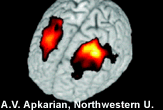How the Brain Changes Channels

Your brain cells change channels sort of like a television, scientists say.
Specific cells in the noggin can change what they allow through their membranes by swapping one kind of channel, or membrane opening, for another. This lets your brain fine-tune messages and adjust connections to control fine motor skills, like fumbling with your keys. This channel-changing ability has been recognized for a few years, but the mechanism wasn't known. Now a team at Johns Hopkins University has identified two proteins that flip channels in mice.
These two proteins help replace channels that let calcium into a cell with another kind of channel that keeps calcium out.
A brain cell's activity level depends on its neighbors - the nerves and other cells that connect to it. They don't physically touch, but a cell and its neighbor are close enough that molecules released from one can travel directly to the next. These molecules dock at specific receptors on the cell's membrane and trigger the opening of gate-like channels. Depending on the receptor and the channel, sodium, calcium, chloride, or other charged atoms will flow into the cell.
Researchers applied an electrical shock to a specific channel that normally allows both sodium and calcium to enter the cell. Within minutes the channel had been swapped with one that still let sodium in but kept calcium out.
The findings are detailed in the March 24 issue of Neuron.
The researchers speculate that the cell is engaging in self-preservation, since too much calcium inside a nerve cell can kill it. Calcium has many jobs inside cells, and the channel swap might accomplish more than just keeping the cell alive. "Calcium turns some processes on, and it turns others off," said Richard Huganir, a neuroscientist at the Howard Hughes Medical Institute at Johns Hopkins. "My personal belief is that the cells might be doing more than just protecting themselves by keeping calcium out." In some cases, protection might be enough of a goal. Muscle-controlling nerve cells in people with Lou Gehrig's disease die because too much calcium gets inside. If doctors could swap the calcium-allowing channels in these cells for the kind that keeps calcium out, it might be possible to prevent the cells from dying. "But that's a big 'if' at this point," Huganir said.
Sign up for the Live Science daily newsletter now
Get the world’s most fascinating discoveries delivered straight to your inbox.
- Your Brain Works Like the Internet
- Men and Women Really Do Think Differently
- Brain Breakthrough: Scientists Know What You'll Do
Mind Control of External Devices
Ancient Behaviors Hard-Wired in Human Brain












